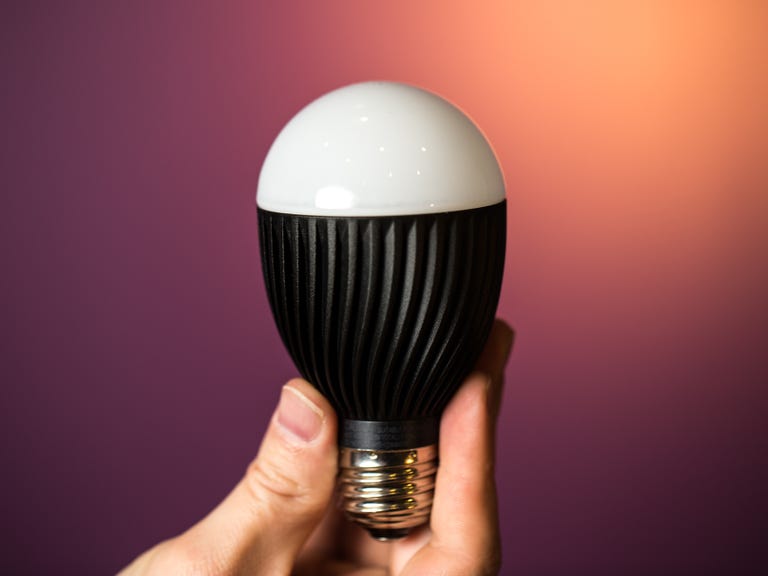 Why You Can Trust CNET
Why You Can Trust CNET Misfit Bolt review: A few misfires with Misfit's colorful, likable smart bulb
The Misfit Bolt promises to add some color to your living space and help you rise and shine in the morning.
In Misfit's product catalog, the color-changing Bolt Bluetooth smart bulb looks to be, well, a bit of a misfit. After all, this is a company that's best known for its wearable tech -- what the heck is a light bulb doing in the mix?
The Good
The Bad
The Bottom Line
Look a little closer and you'll see why Misfit Bolt makes sense. Pair it up with your phone over Bluetooth, and you'll be able to control and adjust your lighting by using an app -- or by using its integration with Misfit's activity trackers. You can also sync Bolt up with your sleep patterns and program it to wake you up in the morning with a gradual sunrise simulation -- a nice companion piece for anyone who tracks their sleep using a Misfit wearable, or with Misfit's Beddit sleep monitor.
Currently selling on Misfit's website for $43, the Misfit Bolt isn't a bad deal compared with pricier competitors like the $60 Lifx LED. You also don't need a hub plugged into your router in order to sync your phone with it, which makes it an easier option to get started with than something like Philips Hue.
That said, Bolt isn't as bright as either of those options, and it isn't as fully featured, either. You can't sync it up with your music, nor can you control it through a system like IFTTT or Amazon Echo. For basic color-changing smart functionality, it does a fine job, but the competition feels further ahead.
Design and features
The Misfit Bolt stands out for its distinctive design, with a metallic black base built from neatly spiraling heat sinks. It's heavy, weighing just under half a pound, and it feels expensive and luxurious in your hand, in case that's the sort of thing that factors into your light bulb buying decisions.
Of course, hidden under a lampshade, the only design factor that really matters is how the light looks. In this sense, the Misfit Bolt might leave you underwhelmed. With a dome-shaped bulb that doesn't bulge out any further than the base does, the light is non-omnidirectional. That means that it if you screw it into a table lamp, it'll send most of its light up and out. That isn't ideal if you're trying to read beneath it.
Bolt casts more light upward than downward.
The bulb also defaults to a dimmer-than-you-might-like soft white setting of about 600 lumens. You can dial it up to the claimed 800-lumen light output if you pull out the app, but that's a clear annoyance if you put a premium on brightness.
The app itself makes a better first impression. It's slick and colorful, with attractive tiles for a wide range of color-changing presets -- everything from "Forest," which cycles through green tones, to "Volcano," which offers a mix of reds, pinks and oranges. Scroll down through those preset options, and you'll notice a dynamic parallax effect to the imagery. It's a stylish look, with plenty of polish.
It's a different approach than most other smart color-changers, which tend to keep those color cycles relegated to a special features section of the app (if they offer them at all). Misfit puts them front and center, pitching them not as an extra feature, but as the primary use case. I can see the appeal -- for some users, selecting a specific mood made of a mix of colors will seem a lot simpler than picking out an exact shade on a full-spectrum color selector.
Mind you, Misfit won't stop you from fidgeting with a full spectrum of colors. Tap the little plus sign on the home screen, and you'll be able to go into color mode, where a rainbow-hued ocean of pixels awaits, complete with a white-light spectrum on top. Drag the little light bulb icon representing your Misfit Bolt over the color of your choice, and presto, the bulb will change color accordingly.
Bolt's color controls are very similar to the Philips Hue's (left). The color-wheel approach that Lifx uses (right) is a bit easier to work with.
It's almost exactly the same as the color selection spectrum in the Philips Hue app. I don't like it there, and I don't like it here, either. It's a pain trying to dial in to an exact shade, especially since your finger will block your view as you drag that bulb icon around. I much prefer the Lifx approach, which spreads that spectrum around a color wheel, then lets you pick a specific shade by rotating it to the top. Even better, Lifx labels each color as a specific degree in the circle. That makes it easy to return to your exact shade of choice.
Beyond the preset color cycles and the full spectrum color selector, you can also pick a color from one of the photos on your phone, or set the bulb to turn on and off automatically as you come in and out of Bluetooth range. This last bit wasn't terribly useful when I tested it out -- the bulb turns off reliably enough, but has trouble turning back on when you come back into range. In fairness, Misfit still lists this as a beta feature, so perhaps after some more fine-tuning it'll work a little better.
Other features are aimed more at syncing with your sleep schedule. For instance, you can put the bulb on a sleep timer and set it to gradually fade out over a predetermined length of time, or program the "Sunrise" preset to wake you up with some artificial morning light at the time of your choice.
Both features work well, but if you're hoping for any sort of additional scheduling, you'll be disappointed. Also missing: a music syncing feature. Almost every other smart bulb offers some way to get the lights flashing in rhythm with your party mix -- especially the ones that pair directly with your phone. Misfit does not, which seems like a missed opportunity.
The other omission separating Misfit Bolt from the majority of the competition is a lack of integrations with outside platforms. For instance, you can't sync the bulbs up with the Amazon Echo smart speaker to enable voice activated lighting changes, the way you can with both Lifx and Philips Hue. You won't find support for platforms like Apple HomeKit, either.
Performance
As color-changing bulbs go, Misfit Bolt gets arguably the most important part -- the colors -- right. When I tested the bulb out in our integrating sphere and spectrometer setup, each of the major shades tested well for accuracy, including green, a color that Philips Hue bulbs struggle with.
The brightness of those colors was less impressive. Like with Lifx, the bulb starts adding white light when you dial up past 50 percent brightness, and at full brightness, those tinted tones were plenty bright. But back at 50 percent, where you get those pure, saturated colors, things were noticeably dimmer than what you'll get from the competition.
For the most part, Bolt's color quality is right on the money.
Compared with the first-generation Lifx bulb, this largely comes down to the power draw. At 17 watts, the first-gen Lifx was plenty powerful, enough so to call itself a 75W replacement. The Misfit Bolt draws 13 watts, and only gets up into 60W replacement territory at specific parts of the spectrum.
It's worth noting, though, that Lifx cleaned house on its stock of first-gen bulbs over Black Friday, just as it began ramping up sales of its second-gen bulb, the Lifx Color 1000. That bulb only draws 11 watts, but still claims to put out more light than the Misfit Bolt. We'll be reviewing it later this month.
Misfit Bolt's overall dimness leads me to say that the bulb isn't a great pick for anything more than an accent light. That seems to be Misfit's intention here, seeing as how the bulb is prominently geared for a bedside table lamp with its sleep timer and Sunset mode. However, that only calls the non-omnidirectional build back into question. Something omnidirectional would have been a much better fit, especially for anyone who likes to read in bed.
While I had the Misfit Bolt screwed into our integrating sphere, I made sure to also test out how well it dims. The result was a good one. Using the app, it dims cleanly down to about 7 percent before shutting off. Anything below 10 percent is a success in my book, though it's worth noting that Philips Hue bulbs are able to dim down below 1 percent.
I also took a look at how well those spiraling heat sinks help the bulb manage heat. All LEDs will see their brightness dip by about 10 or 15 percent as they heat up, and Misfit is no different. The dip should stop at the bulb's "steady state" after about an hour (this steady state is where manufacturers rate the bulbs for brightness, and where we test them, too, so you aren't getting shortchanged on the lumen listing.)
With Misfit Bolt, though, it took about 90 minutes before the bulb finally leveled out. That's an acceptable result, but not as good as we've seen with other LEDs. The practical takeaway is that it probably isn't the best bet for an enclosed fixture, where heat gets trapped.
The verdict
Misfit Bolt isn't the best color-changing bulb I've tested out, but at a retail price below $50, I think it deserves consideration, especially for anyone who just wants a fun, colorful novelty light. For the most part, the app is terrific and easy to use, and the colors the bulb puts out are true. It'd be even better with a music syncing feature, but that isn't a deal breaker in my eyes.
Still, Bolt isn't as bright or as fully featured as competitors like Lifx, iLumi and Philips Hue, and its limited Bluetooth range isn't as appealing as the Lifx Wi-Fi approach. With second-gen Lifx bulbs starting to hit store shelves, I think you'll want to do a close comparison between the two before making a purchase. We'll be doing our own when we test out the Lifx Color 1000 -- look for that review in the coming weeks.


